The world we live in today seeks precise and instant solutions. The same is true when finding vulnerabilities that might remain hidden within an organization’s assets. This blog discusses the best VMDR and pentesting tools that help find vulnerabilities fast and are accurate in their findings. Additionally, there are multiple factors that need to be assessed when looking for the best VMDR and Pentesting tool in 2025. A few of the aspects that an organization must consider are primary functions, scope, deployment options, supported platform, false positives, scan type, multi-integration system, reporting and analytics, user interface, pricing model, and many more.
Table of Contents
Top 3 VMDR and Pentesting Tool
Provided below are the top three best VMDR and pentesting tools along with their comparison:
AutoSecT
With its 12 core capabilities, AutoSecT stands out as the ultimate vulnerability management tool. Its prime task is to identify, manage, and recommend vulnerabilities with comprehensive pentest solutions. It has a centralized vulnerability management dashboard where users can easily manage projects, schedule smart scans, perform bulk scanning, and many more. Furthermore, it is an all-in-one asset manager that ensures users with effortless vulnerability lifecycle management. Not only that, the multi-integration VMDR tool also helps in VAPT Vendor Management and generates online VAPT certificates that are easily verifiable. After the scanning is done, AutoSecT generates Password Protected Reports as well as professional reports with unified branding.
Additionally, Kratikal’s VMDR and Pentesting Tool, AutoSecT, enforces role-based access control (RBAC) within workspaces, and tracks project progress with status updates and task completion rates as well as milestone achievements. It offers configurable scans, supporting both Authenticated and Non-Authenticated testing, with seamless integration to Burp Suite Enterprise for manual testing. It evaluates vulnerabilities by assessing CVSS scores, impact, and exploitability while overcoming challenges like CSRF tokens, stateful functionality, and volatile URLs. The tool identifies hardcoded secrets and insecure configurations in mobile apps, supports cloud platforms like AWS and GCP, and assesses cloud container services such as AWS ECS and GKE.
With the JSON File Endpoint Scanner feature, users can upload a JSON file and scanned to retrieve all the API endpoints present within the file in case of API automation. The system extracts, processes, and displays the relevant endpoint routes from the uploaded JSON data. With AutoSecT, custom security checks can be created based on compliance and industry standards, while providing best practice recommendations to enhance overall security.
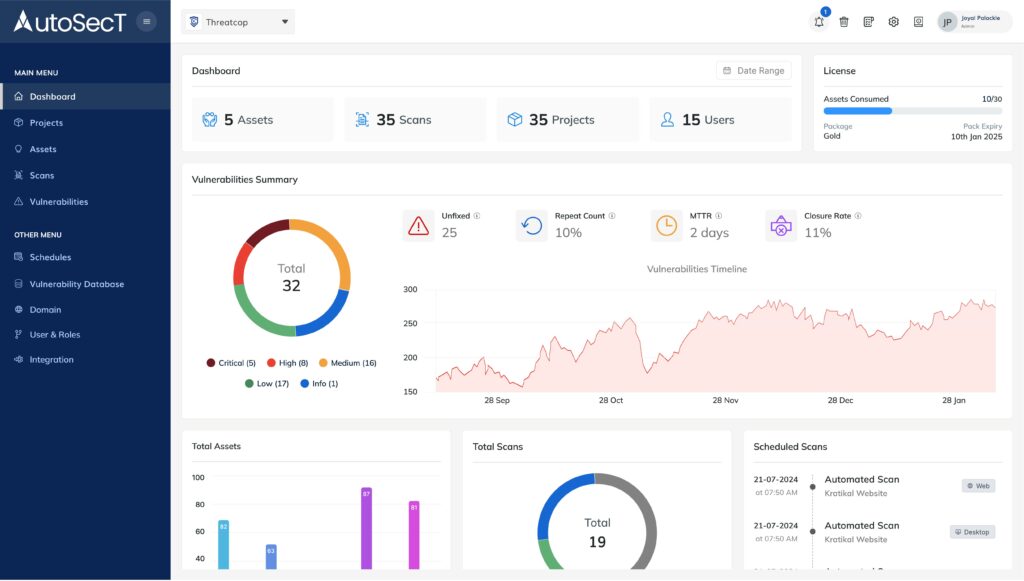
AutoSecT in Numbers:
Till 2024, AutoSecT has identified over 1.2 million vulnerabilities per year. Furthermore, it has secured over 1150 web applications, 750+ mobile applications, 2200+ cloud assets, and over 6000 APIs. In terms of test cases handled, the tool has crossed the 12000 mark.
Strengths: Simple setup, targeted vulnerability scanning, as well as cost-effective for small teams.
Limitations: Need for more infrastructure scanning capabilities except for web apps, mobile apps, cloud, and API.
Book Your Free Cybersecurity Consultation Today!
Nessus
Nessus is a vulnerability assessment tool. It is developed principally for scanning vulnerabilities. Apt for small and medium-sized enterprises, it also offers on-premise and cloud deployment options. It supports platforms like Windows, Linux, and Mac. While it focuses on vulnerability and configuration scanning, it does not offer web application scanning. Users have reported higher false positives, particularly on Linux systems with certain applications.
Nessus integrates with tools like Splunk, JIRA, and ServiceNow for enhanced functionality. Its customizable reports can be exported in CSV/JSON formats. While it has basic remediation tracking and a straightforward user interface, Nessus requires additional tools for comprehensive vulnerability management and tracking.
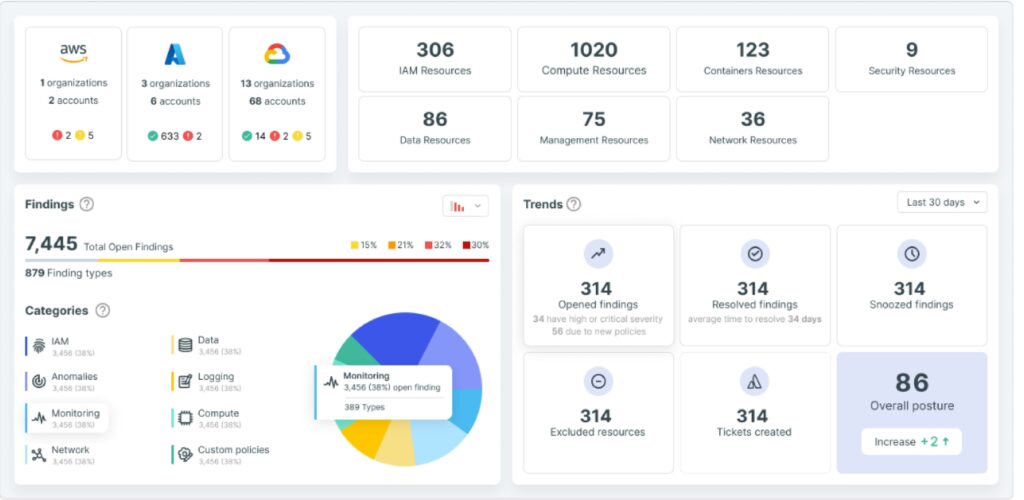
Strengths: Specialized network vulnerability scanning.
Limitations: Restricted web and cloud security, with additional tools required for extended functionalities.
Qualys
Qualys, the vulnerability management and scanning solution, is designed for medium to large enterprises. It is cloud-based and supports platforms such as Windows, Linux, and Mac. Also, it supports the network and provides web application scanning capabilities. It integrates with other systems via APIs. While it offers customizable reporting in multiple formats, users may experience a steeper learning curve due to its comprehensive interface.
The higher incidence of false positives requires thorough validation. Also, the higher price point and additional fees for advanced features might be a limitation. The tool provides comprehensive customer support making it well-suited for organizations with complex security and compliance requirements.
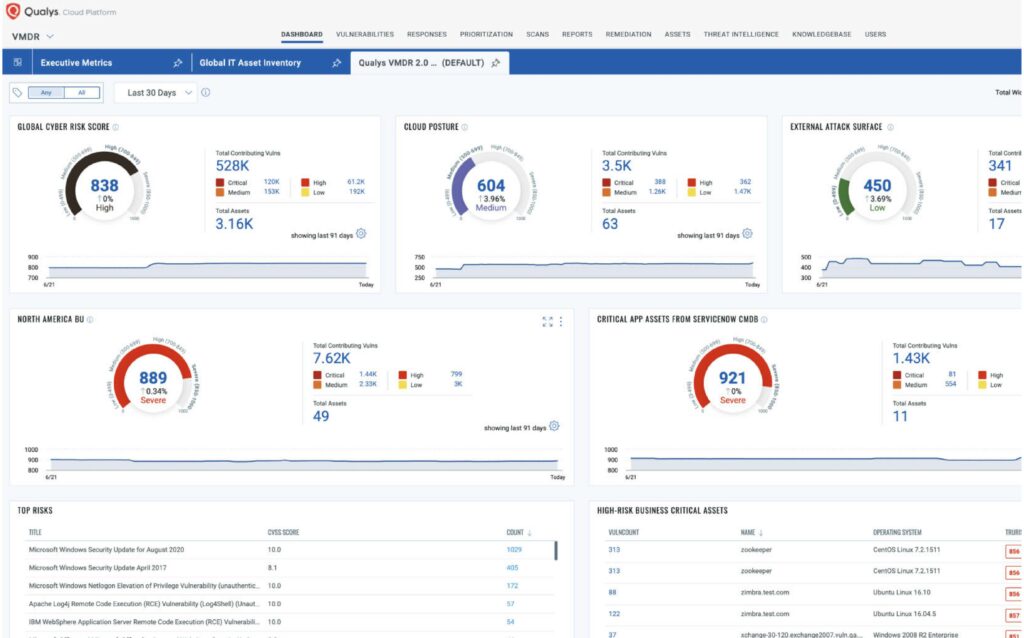
Strengths: Comprehensive features, robust compliance modules, and cloud-native deployment.
Limitations: More complex learning curve, with extra fees for advanced features.
VMDR and Pentesting Tool Comparison
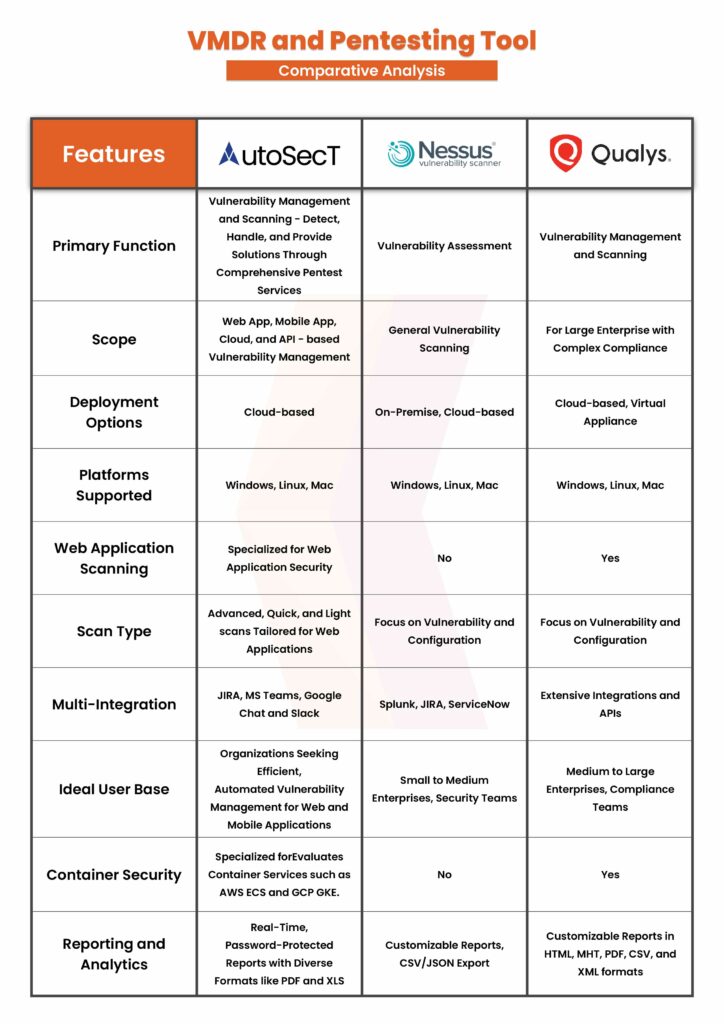
Primary Function
AutoSecT, the VMDR and Pentesting Tool of Kratikal focuses on vulnerability management and scanning. It offers a comprehensive means to identify and further mitigate security risks with pentest solutions. Nessus is known for its vulnerability assessment capabilities in detecting vulnerabilities across various environments. Qualys combines the strengths of both by providing vulnerability management, and scanning.
Scope
AutoSecT focuses on vulnerability management and scanning for web apps, mobile apps, cloud, and API. Moreover, it has a user-friendly interface with real-time monitoring and provides higher grounds in terms of accuracy. Nessus is focused on providing solutions for general vulnerability scanning. Comprehensive vulnerability management and tracking can be achieved as well with supplementary tools. Qualys has an extensive feature set. Thus, it is suited for large enterprises dealing with complex compliance requirements.
Deployment Options
The VMDR and pentesting tool of Kratikal is exclusively cloud-based. AutoSect is capable of offering seamless scalability and easy access without the need for extensive infrastructure. Nessus provides flexibility with both on-premise and cloud deployment options. It caters to organizations that prefer in-house control or cloud convenience. Qualys offers a hybrid approach. It is deployed as a cloud-based solution or as a virtual appliance.
Web Application Scanning
In terms of web application scanning, AutoSecT specializes in web application security. The scanning features of the VMDR and Pentesting tool also help identify vulnerabilities present in web applications effortlessly. Nessus does not offer a web application scanning feature as part of its core functionality. Similarly to AutoSecT, Qualys also offers comprehensive web application scanning.
Scan Type
AutoSecT offers three scan options – Advanced, Quick, and Light. They are carefully crafted with a focus on speed and efficiency in vulnerability detection for web applications. Nessus and Qualys shift their focus primarily on overall vulnerability and configuration scanning.
Multi-Integration System
AutoSecT fosters team collaboration. The pentesting tool provides multi-integration with the following platforms – JIRA, MS Teams, Google Chat, and Slack streamlining communication and incident tracking. The key platforms for integration with Nessus are Splunk, JIRA, and ServiceNow. Qualys extends its workflow automation through its extensive integration options and APIs.
Reporting and Analytics
AutoSecT prepares password-protected, real-time reports in formats like PDF and Excel. Thus, enabling swift and secure access to critical insights. Nessus delivers customizable reports and provides the scope for flexibility through its export options in CSV and JSON. Qualys focuses on generating customizable reports in HTML, MHT, PDF, CSV, and XML.
Remediation Tracking
AutoSect focuses on real-time action by security teams. In order to ensure swift action, the VMDR and Pentesting tool focuses on providing immediate visibility into the vulnerabilities identified. Nessus offers remediation tracking that allows vulnerability identification, however, with limited tracking features. Qualys offers an integrated ticketing system for advanced remediation tracking. As Qualys is well suited for large and complex organizations, AutoSecT stands out for its rapid response.
User Interface
AutoSecT was assembled with an easy-for-all motive. Its intuitive and user-friendly interface simplifies the vulnerability assessment process, hence, making it easy to use even for the less-experienced users. Nessus interface is built straightforwardly focused on vulnerability scanning. In the case of Qualys, the user interface is a bit complex with a broader range of security functions and might require assistance for new users.
Pricing Model
The pricing of AutoSecT is flexible with a free trial. It allows organizations to test and explore before committing. Nessus follows a subscription-based model. It charges per agent or IP making it cost-effective for small and medium-sized businesses. The pricing model of Qualys is similar to Nessus with additional fees for compliance modules.
Ideal User Base
For those organizations seeking a VMDR and pentesting tool that is automated and efficient in vulnerability management for web apps, mobile apps, cloud and API, AutoSecT is the best option, irrespective of organization size and industry. Nessus is best suited for security teams and small to medium-sized organizations. Qualys is best suited for medium to large enterprises as well as compliance teams.
Selecting the right VMDR and Pentesting Tool in 2025 is a crucial decision. Thus, every organization must aim to secure its assets in the best possible way looking at the evolving threats. One of the best VMDR and pentesting tools is AutoSecT from Kratikal along with Nessus and Qualys, each with its own strengths and limitations. However, for organizations prioritizing web and mobile security, AutoSecT emerges as the clear leader, offering a user-friendly, scalable, and highly effective solution for automated vulnerability management. As threats continue to evolve, investing in the right VMDR and Pentesting tool is essential.
FAQs
- Which is the best VMDR and Pentesting Tool in 2025?
The best VMDR and Pentesting Tool might vary from organization to organization based on their need. AutoSecT is ideally suited for all organizations who are looking to scan vulnerabilities in multiple assets like web apps, mobile apps, cloud, and APIs in a single dashboard.
- What makes AutoSecT stand out from other VMDR and Pentesting Tools?
The main feature that makes AutoSecT stand out as the best VMDR and Pentesting Tool is that organizations can keep track of the vulnerabilities in multiple assets in a single dashboard. Apart from that its user-friendly interface, customization options, workspace sharing, multiple scan types, progress tracking, expert guidance, and cost-effective pricing among many others make it the best VMDR tool so far.


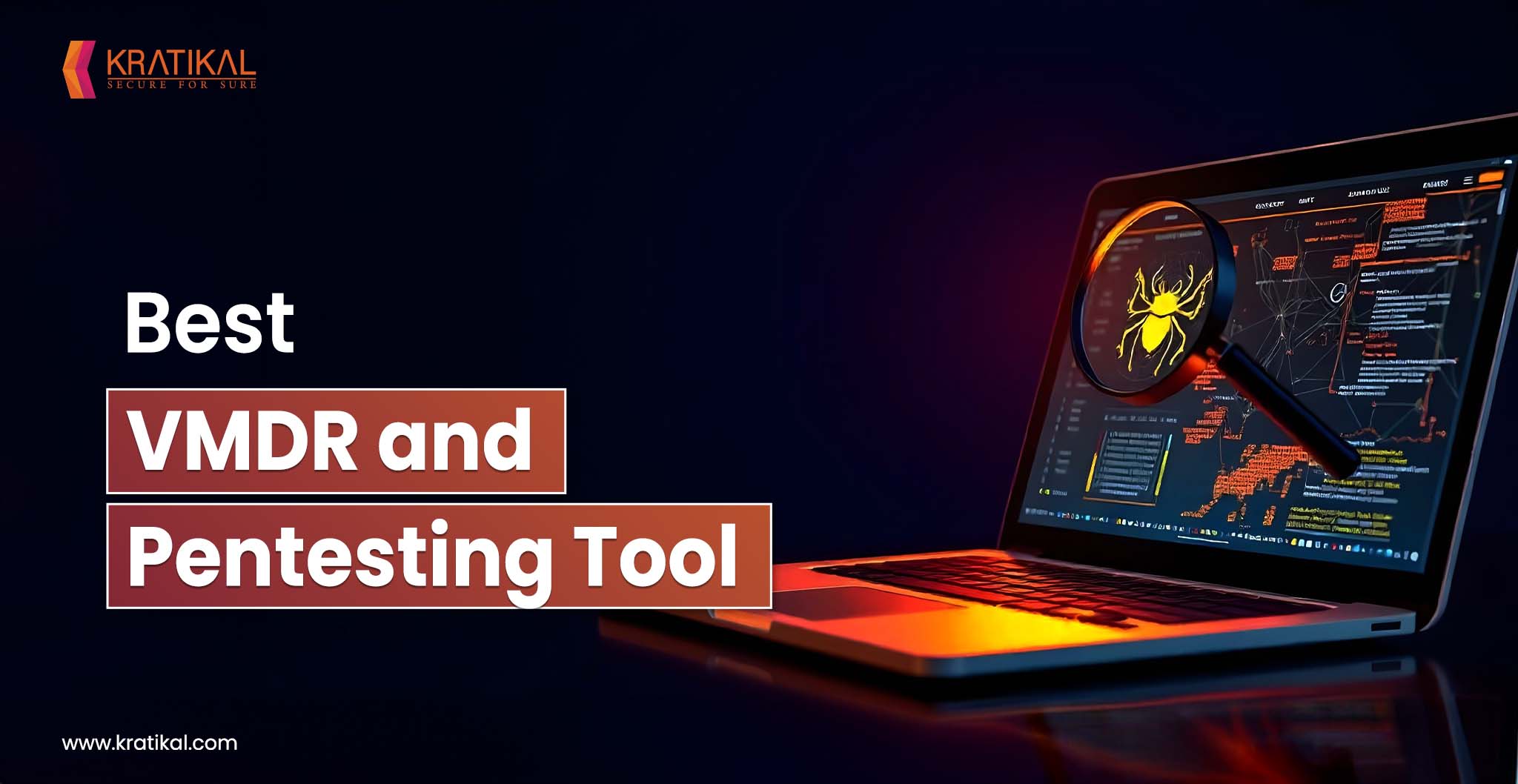



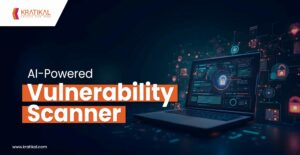

Leave a comment
Your email address will not be published. Required fields are marked *